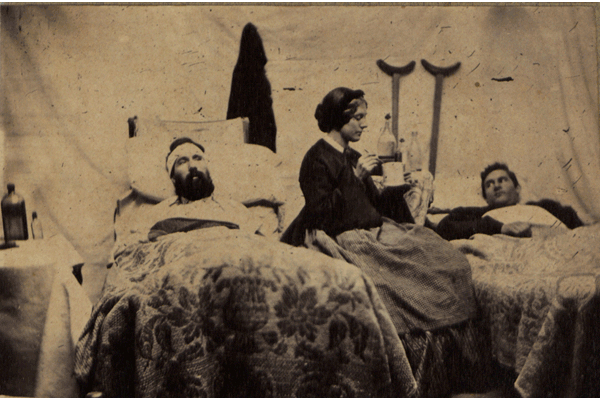Pain Management in History: Morphine and the Civil War
Pain Management in History: Morphine and the Civil War
Dave McNamara

September is National Pain Awareness Month. In awareness of the month, this blog will take a three-part look at pain management: in the past, present, and future. To begin, let’s start with the past.
Pain in War
The importance of pain management during wartime has always been crucial. Yet one war was, in part, defined by it: The Civil War. Not only because of the number of casualties or wounded soldiers in need of pain relief, but also because The Civil War is a fitting place to discuss America’s complicated history with an effective, yet addictive, painkiller: opioids.
Grim Statistics
Based on personal research, the facts and statistics of The Civil War are widely debated and widely vary. However, one fact remains clear: it was America’s deadliest war. The number of casualties ranged in number from 500,000 to 620,000, and even 850,000 (in comparison, the Revolutionary War saw approximately 4,440 casualties). Another fact also seems clear. Most soldiers didn’t die on the battlefield. Though the figure is also approximate, it’s been cited that as many as two-thirds of all casualties were due to disease contracted while under medical care.
Healthcare and The Civil War
Many people have been very critical of healthcare during The Civil War. It’s true the medical community was ill-equipped for the enormity of the war. Amputations were common, knowledge of bacteria causing infections was not fully understood, as was the necessity of sterilizing equipment. Yet as tragic as this was, the tragedy brought about major medical advances. The website The Civil War Trust states, “modern hospital practices and treatment methods owe much to the legacy of Civil War medicine.”
An Advance in Pain Management
Perhaps the biggest advancement was pain relief. This was most often accomplished by administering a new compound from an ancient drug: Morphine, an opiate extracted from poppy.
A Brief History of Opioids and the US
There’s not enough space to get into the history of opioids, here. It’s a strange one, though. Opiates have been known and used as far back as 4300 BC.
Opioids seemed to find its way to America in the 18th century when Chinese immigrants brought it with them in the form of opium. Opium at the time was not restricted, and as a consequence opium addiction rose. Morphine was, in fact, an attempt by the medical community to find a form of opiate less addictive than opium, yet retaining its medical benefits. Between 1805 - 1816, a pharmacist's assistant named Friedrich Wilhelm Serturner was able to isolate a compound of opium that he felt did the trick. He named it Morphine.
The “Wonder Drug”
Morphine was available before The Civil War, but wasn’t used as widely until doctors prescribed wounded soldiers Morphine as pain relief. It was originally touted as a wonder drug because of its success in pain relief. However, morphine proved to not less addictive than opium but more so.
Morphine After the War
When the war ended, America saw scores of soldiers hooked on morphine. Morphine use officially entered civilian life. One could order it from department stores with no oversight. There was a spike in morphine addiction, in particular, to women needing respite from the tediousness of tending house. Soon enough, morphine addiction became an epidemic.
Morphine has not been the only form of an opiate freely available in America, however. Perhaps the most shocking form to us today was a newer, stronger form named heroin: easily available over the counter for a number of different symptoms. But that’s still to come in the early 1900s.
Opioid Use Today: A Renewed Debate
Of course, opiates are still used today as pain relievers. They’re now restricted and can only be prescribed by a doctor. Today, the form opioids take in for medicinal purposes is pills - hydrocodone or oxycodone - combined with acetaminophen (Tylenol). And even though opiates are centuries old, they’re still effective for those suffering from chronic pain, cancer patients, and those recovering from surgery.
But opioid abuse is once again a concern. Recent reports show a dramatic rise in opioid abuse. It seems most are addicted to the pill form, but many have turned from prescription opioids to heroin. Heroin is now a scheduled drug and illegal (and plays an important part in another war: Vietnam). But oddly, this makes heroin both cheaper and easier to get.
Conclusion
Though the current opioid “epidemic” is not nearly as widespread as it was after The Civil War, it does seem that we as a country keep coming back to the issue of opioid use as relief from pain. On the one hand, it does its job, and bring those in real pain the relief they need. On the other hand, opioids, no matter what form it takes, remain highly addictive and abused. There is no consensus on what’s to be done among the medical community. But I’m sure it will be discussed this month. And for quite a while after.
References
- America’s Wars Fact Sheet. Washington, DC: Department of Veterans Affairs, 2016. http://www.va.gov/opa/publications/factsheets/fs_americas_wars.pdf.
- Trust, Civil War. ‘Civil War Facts’. 2014. Accessed September 5, 2016. http://www.civilwar.org/education/history/faq/?referrer=https://www.google.com/.
- Mandal, MD, Dr. Ananya. ‘Morphine History’. October 27, 2013. Accessed September 5, 2016. http://www.news-medical.net/he... reference
- Adrienne, Carole. ‘About Morphine Use During the Civil War’. 2011. Accessed September 2, 2016. http://civilwarrx.blogspot.com/2014/03/about-morphine-use-during-civil-war.html.
- Dixon, Ina. ‘Civil War Medicine’. 2014. Accessed September 3, 2016. http://www.civilwar.org/education/history/civil-war-medicine/civil-war-medicine.html?referrer=https://www.google.com/.
- Loker, Thomas W. ‘Women & Addiction: History Replayed!’. July 3, 2013. Accessed September 5, 2016. https://tloker.wordpress.com/2... Tavernise, ‘C.D.C. Painkiller Guidelines Aim to Reduce Addiction Risk’, Health (The New York Times), March 16, 2016, http://www.nytimes.com/2016/03/16/health/cdc-opioid-guidelines.html?hp&action=click&pgtype=Homepage&clickSource=story-heading&module=first-column-region®ion=top-news&WT.nav=top-news&_r=0#story-continues-
- CDC. ‘Increases in Drug and Opioid Overdose Deaths — United States, 2000–2014’. January 1, 2016. Accessed March 16, 2016. http://www.cdc.gov/mmwr/preview/mmwrhtml/mm6450a3.htm.
